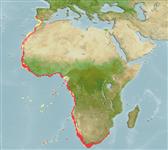Common names from other countries
Environment: milieu / climate zone / depth range / distribution range
Ecologia
; intervalo de profundidade 25 - 774 m (Ref. 104453). Tropical; 39°N - 37°S, 18°W - 33°E
Eastern Atlantic and Western Indian Ocean: Morocco, Gibraltar Strait to Durban, South Africa.
Length at first maturity / Tamanho / Peso / Idade
Maturity: Lm ? range ? - ? cm Max length : 14.0 cm TL macho/indeterminado; (Ref. 434)
Occurs at depths of 50 to 450 m with juveniles common at 50 to 100 m (Ref. 8). Inhabits sand and mud bottoms. Feeds on benthic organisms (polychaetes, small crustaceans and mollusks (Ref. 434).
Life cycle and mating behavior
Maturidade | Reprodução | Desova | Ovos | Fecundidade | Larvas
Members of the order Decapoda are mostly gonochoric. Mating behavior: Precopulatory courtship ritual is common (through olfactory and tactile cues); usually indirect sperm transfer.
Holthuis, L.B. 1980. (Ref. 8)
Categoria na Lista Vermelha da IUCN (Ref. 130435)
Categoria CITES (Ref. 108899)
Not Evaluated
Not Evaluated
Utilização humana
Pescarias: pouco comercial
| FishSource |
Ferramentas
Mais informação
Idade/TamanhoCrescimentoComprimento-pesoComprimento-comprimentoMorfologiaLarvasAbundância
Fontes da internet
Estimates based on models
Preferred temperature
(Ref.
115969): 9.2 - 15.9, mean 11.9 (based on 131 cells).
Vulnerabilidade
Low vulnerability (10 of 100).
Categoria de preço
Unknown.
